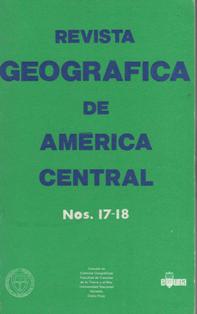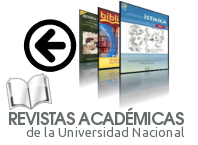EL PROCESO DE URBANIZACION EN LA PERIFERIA DEL AREA METROPOLITANA: LOS CASOS DE TURRUCARES Y MONTE DE LA CRUZ
Palabras clave:
urbanización del espacio agrícola, espacio suburbano, proceso de metropolizacionResumen
Este avance de investigación pretende ofrecer una visión preliminar de un fenómeno bastante reciente que se está dando en Costa Rica y particularmente en el Valle Central: la urbanización del espacio agrícola. Este proceso se está desarrollando más allá del espacio suburbano y presenta una especialidad diferente, ya que aquí la organización social campesina y las actividades agropecuarias siguen siendo predominantes. Sin embargo, esta extremadamente vinculado con el proceso de metropolizacion que surge en el país. Se está asistiendo, pues, a una reubicación de los espacios residenciales de las clases de mejores ingresos, las cuales influenciadas tal vez por un modelo ideológico importado, buscan poder disfrutar de las ventajas que ofrece el espacio rural pero con la posibilidad de seguir trabajando en la ciudad y seguir gozando de los servicios urbanos. La rural-urbanización dentro de una estrategia global de estructuración del espacio puede ser considerada como un mecanismo de selección y una apropiación de los mejores lugares donde se dará la futura de expansión urbana. Desde esta perspectiva, resulta interesante llamar la atención de cómo ciertos sectores sociales están proyectando desde ahora la futura expansión del espacio metropolitano.
SUMMARY
This preliminary investigative report presents a viewpoint about a very recent phenomenon that is occurring in Costa Rica and especially in the Central Valley: the urbanization of the agrarian space. This process is developing beyond the suburban areas and presents a different spacial structure because in these areas, the rural social structures and the livestock and agricultural activities are still predominant. Nevertheless, such activities are very much related to the urbanization process occurring in the country. As such, we are witnessing a reubication of the residential structure of the high-income classes, of which, influenced perhaps by an improved idiologic model, hope to enjoy the advantages offered by a rural area but also taking advantage of the convenience offered by the urban benefits; plus the opportunity to keep working in the city. The process of rural urbanization conceived in a global strategy of spatial structures, can be considered as a selection and appropriation mechanism of the best areas for the future urban expansion. From this perspective, it is interesting to call attention to the process by which certain social sectors are now projecting the future organization of the metropolitan area. In reference to the real-estate capital invested in the study areas, and specifically to Costa Rica capital, this investment in the promotion of real-estate, acts as a shelter sector, by changing the course of direction of the capital accumulated in the other economic sectors, especially considering that the real-estate sector insures more secure profits in spite of the relatively insignificant recuperation rate of the capital investment comparison to the industrial sector, where more capital risks occur, above all during an economic crisis. At present, the zones influenced by rural urbanization are affected by a modification in their productive structure, in other words, what were once agricultural zones, are now converted to residential zones. This produces spectacular changes in the composition of the work force by producing service-oriented employment that leads to the following abandonment of the agricultural activities. From a social point of view, this rural urbanization pattern provokes a marked spatial segregation, in which an exclusive high income social group with a particularly consuming life style is noted at one level, and on the other, social groups that inhered patterns of rural life with more traditional lifestyles. In reference to the community level in the study areas, localized conflicts have emerged between local people and the new residents. These conflicts are highly conditioned by the insertion in the communities of these new residents.
RESUME
Ce document préliminaire décrit un phénomène assez récent au Costa Rica, qui affecte plus particulièrement la « Vallée Centrale ». il s’agit de l’urbanisation de l’espace agricole. Ce sont des espaces franchement ruraux, bien au-delà des banlieues, qui sont affectés par ce processus qui, en conséquence, montre des caractères différents: comme se maintien de la organisation social liée aux activités agricoles; en face l’infiltration d’un autre mode de vie dû à sa transformation en espace résidentiel pour classes aux revenus élevés qui, peut-être, influencées par un modèle culturel importé, préfèrent une localisation qui puisée leus offrir à la fois les avantages de vivre dans un espace rural avec ceux de la ville, lieu de travail suffisamment proche dont elles continuent à pouvoir utiliser ses services. Ce modèle culturel doit être considère en fonction du processus de métropolitain apparu dan le pays. L’urbanisation de l’espace rural, dans une stratégie globale de structuration de l’espace peut se considérer comme un mécanisme de sélection et d’appropriation des meilleurs sites de l’expansion urbaine future. Dans cette perspective, il est intéressant de constater qu’il existe déjà, de la part certains secteurs sociaux, un projet d’organisation de l’espace métropolitain futur. Le foncier est considéré comme un secteur refuge pour les capitaux nationaux d’où l’intérêt de la spéculation pour ces zones. En effet, ce placement, plus sûr, malgré un plus faible taux de récupération du capital, est préfère à d’ autres- comme l’investissement industriel- plus rentables, mais plus risqués, surtout en temps de crise. L’urbanisation de l’espace rural s’accompagne d’une modification des structures productives : moins d’agriculture et évolution de l’emploi vers le tertiaire liée à la présence de nouveaux résidents. Du point de vue social, cette situation se traduit par une très nette ségrégation spatiale. D’un côte, un group socio-économique aux revenus élèves représentant la société de consommation ; de l’autre, les ruraux au style de vie plus traditionnel. Il en résulte une certaine tension entre les deux groupes.
Descargas
Cómo citar
Número
Sección
Licencia
Política propuesta para Revistas que ofrecen Acceso Abierto
Los autores que publican en esta revista están de acuerdo con los siguientes términos:
a. Los autores conservan los derechos de autor y garantizan a la revista el derecho de ser la primera publicación del trabajo, bajo la Licencia https://creativecommons.org/licenses/by-nc-sa/4.0/deed.es, que permite a otros compartir con un reconocimiento de la autoría del trabajo y la publicación inicial en esta revista.
b. Los autores pueden establecer por separado acuerdos adicionales para la distribución no exclusiva de la versión de la obra publicada en la revista (por ejemplo, situarlo en un repositorio institucional o publicarlo en un libro), con un reconocimiento de su publicación inicial en esta revista. Esos acuerdos adicionales deben respetar los términos de la licencia: es decir: no involucrar fines de lucro y compartir con la misma licencia.
c. Se anima a los autores a archivar el post-print o versión de editor/PDF en repositorios de acceso abierto.







 REVGEO se encuentra bajo la licencia https://creativecommons.org/licenses/by-nc-sa/4.0/deed.es
REVGEO se encuentra bajo la licencia https://creativecommons.org/licenses/by-nc-sa/4.0/deed.es
.svg_4.png)

_(1).png)
_(1)_(1)_(1)_1.png)
(2)(1)(1)(1).png)
